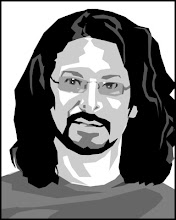 |
| Artemis Kolakis |
Hair that is literally and figuratively an extension of one's self, one's ethos, pathos, logos and kairos (great word; look it up). Hair that speaks intentionally, and realizes that myth today (in a world in which considering discourse best replaces identifying ideology; see the work of David Sholley) is not just a relationship between body (organism), society-culture (environment), and world (Capital W, World), but is an attempt to figure out the relationship between embodiment and technology (i.e., an ecosystem).
Aesthetics as politics. Surface as depth.
Aesthetics as politics. Surface as depth.
My question for today, concerns, as usual, my exploration of fashion as expression, consequent perception, and questions the differences such expression-perception continuum's create when sex and gender (and subjugation and objectification) are added to the mix. The simple question: Can men wear cyberlocks? The Q is re-articulated first by the question; can women? Third, by the question, in what context? Raves only? Work?
 |
| untitled |
The art above and ad alongside this text, are examples of cyberlocks. Essentially, dreadlocks on nanobots: The spiritual, religious, ideological equations with Rastafarian dreads are different, but the connotation is interestingly similar: You stand out. You are your own emblem. You show your allegiance. You communicate a relationship to society.
And here's another part of the issue: Many (far too many) people live at the level of judgement: They don't get to know a person; they evaluate that person on pre-judicial categories, past experiences, and pre-suppositions: All the metaphors are temporal, and either "then" or "later"--not "now."
As fashion is concerned I see a repeating trend: Women have more options than men. [However, while not the focus of this blog (I have written about this elsewhere), women are brutally and financially subjugated for this choice (clawback is always working). More often than not, this choice separates women from finances, encourages a sexualization of embodiment, and puts the body on display as an object. These are all phenomena that takes time and resources away from political action. However, that is not my current trajectory.]
I still feel the need to make sure, with my wife, friends and even co-employees and supervisors that, in the panopticon, I can indeed wear my kilts, boots and so-on, to work. I am privileged to work at an institution of higher education where boundaries are quite progressive and broad, but conservatism is the air we breathe; university pedagogy changes very slowly. While some insecurity is mine to own, some is reasonable. Now, looking at cyberlocks I see another way to integrate my life, as a professor of new computer-mediated communication technology, with my clothes in an overtly political fashion (I must be a closet journalist because I love bad puns).
Of course part of the issue is also the relationship between costuming and, well I want to say "conforming," but the category is...uh..this is a blog, and right now I forget. The thing is, work clothes are already, but not always, costumes. Thus, we have competition. I can always wear a suit and tie, and go to work anytime. Moving away from that costume, in higher education, is easy because, we academics can wear "clothes" that are not "costumes." Jeans. Button shirt. T-shirt. Sneakers. Boots. It all works.
But cyberlocks? Think about other deviations. There was a time when a tattoo could keep you out of a good job. While there are limits, tattoos are quite acceptable. This semester (Fall 2011) I'm seeing more dyed hair than ever before (I've bought some red and blue have not used it yet). I imagine that will become more acceptable in some, if not many, careers. Why not this? Why not for men?
 |
| by DJColdfire |

I am ready your blog its really good the great kilt have very good kilts collection and affordable prices.
ReplyDelete